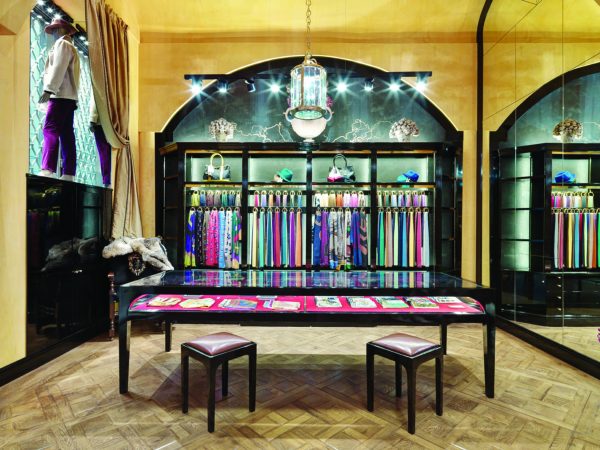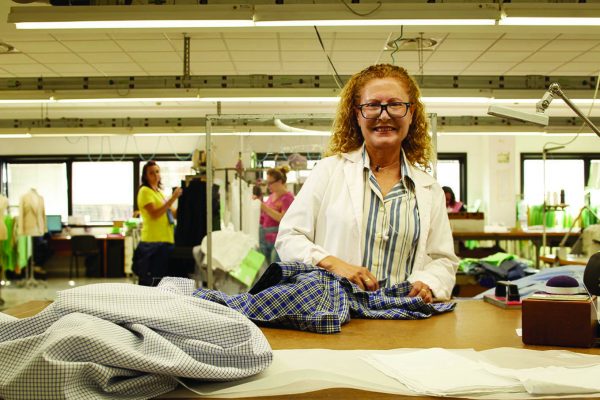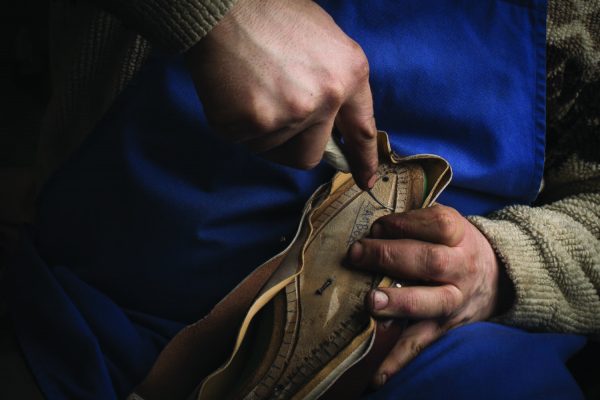Zoey Goto visited Naples on a dapper mini-break, after receiving a rare invitation to take a look behind the scenes at two of the world’s most exclusive and historic tailoring houses.

Until recently, the tailoring and fashion scene in Naples has been shrouded in an elegant cloak of mystery. But now the capital of Campania is awakening to the possibilities of tailoring tourism, to opening up their fabled workshops to curious guests and offering hotel packages with insider access. Visitors to southern Italy’s largest city can now spend a few days educating themselves on the fine art of tailoring and return home with a handsome new wardrobe.
Perhaps the best entry point for understanding Napoli’s style is to stroll its sun-soaked pavements, via the labyrinthine back alleys festooned with clothes lines of billowing garments. It’s here, on the street corners, that the city’s sartorial theatre really plays out, with gentlemen flamboyantly conversing in their uniform of open-necked white shirts and lightweight, unstructured jackets, worn in every shade of blue. The clothing produced in this energetic, chaotic city is all about living the good life, with roomy suits able to accommodate leisurely lunches and super-fine fabrics poetically referred to as being as light as the breeze that blows over Mount Vesuvius.
There’s a hefty dose of the David and Goliath tale in the plucky history of this region’s tailoring, heroically staring down the rising tide of fast fashion. For the past 700 years the humble needle and thread have ruled this city, with hand-stitched garments remaining its speciality. Naples still boasts the highest concentration of bespoke tailoring and shirt makers, with these fashion skills often passed down through several generations.
Romeo Hotel
Tapping into this rich artisan heritage, Romeo Hotel, situated within walking distance of the upscale shopping districts of Via Chiaia and Via Toledo, has started offering guests personalised tours of some of the tailoring greats, including the ateliers of Attolini, Rubinacci, Kiton, Marinella and Isaia. In this age of online shopping, these tours offer a fascinating chance to connect with how and where our clothing is made. The five-star hotel, which includes a rooftop pool overlooking the port of Naples and boasts fine views of Capri and brooding Mount Vesuvius from the Michelin-starred restaurant, can also arrange individual visits to local tanneries to learn about the processes of leather treatment.
Take this study a step further with a visit to the archaeological wonder of Pompeii, less than an hour by train or car from the heart of Naples. Here, amongst the haunting ruins, you can glimpse the remains of one of the earliest tanneries in the world, where animal skins were treated with vegetable dyes in vast vats – using techniques and processes that are not so different from those used today.
Those looking to take the plunge and purchase a suit in Naples shouldn’t be intimidated by eye-watering price tags. The sheer abundance of tailoring houses allows this city to accommodate most budgets, from surprisingly reasonable ready-to-wear suits to bespoke masterpieces crafted to fit like a glove. (It’s worth noting that a bespoke suit may require a couple of appointments, so best to either commit to a return visit to Naples or find a tailor who travels.)
Kiton

At the far end of the cost spectrum is the tailoring house of Kiton, situated in Arzano on the outskirts of Naples. Stepping inside the distinguished workshop, where the workers down their shears at lunchtime to enjoy leisurely, home cooked meals and an atmosphere of quiet concentration fills the air, it quickly becomes clear that this is no ordinary clothing factory.
Founded in 1968, Kiton is a family-run business famed for creating the world’s most costly suit. Kiton’s K50 suit takes a single tailor 50 hours of intricate handiwork and can cost anywhere from £7,500 all the way up to £75,000, depending on the materials used. In a corner of the bustling workshop, studiously working on a client’s K50 jacket is Giancarlo Del Prete, a Neapolitan native who graduated from Kiton’s tailoring school in 2009 and has since risen through the ranks to master tailor. “It’s like reaching the highest peak,” Giancarlo says, pausing momentarily to look up from his precise work. “My job is full of excitement because I am responsible for every step of making a suit. It’s very satisfying.”
Rubinacci
Stepping out onto the palm-tree lined avenue, I leave the Kiton workshop and head across town to meet with third-generation tailor Luca Rubinacci at his family’s boutique. Luca has become a regular on the pages of men’s fashion magazines, being renowned for embodying the concept of sprezzatura – that hard-to-pin-down, nonchalant elegance that appears entirely effortless (even when the exact opposite is true!). Standing in his opulent flagship store, which occupies prime position on Via Chiaia’s cobbled street, Luca is framed by a rainbow of colourful silk scarves, suede loafers and racks of the relaxed suits that have become the house style. It was back in 1930 that Luca’s grandfather, Gennaro Rubinacci, helped to revolutionise and reweave the fabric of Italian tailoring, as “the first to deconstruct a jacket. His clients wanted to wear suits and jackets not just for work but also for the pleasure of being elegant, to enjoy la dolce vita”.
Luca’s hometown of Naples, a city both gritty and ravishingly beautiful in equal measures, has predominantly fallen under mass tourism’s radar. Those who do visit are often passing though en route to Pompeii or setting sail for the picturesque islands of Capri and Ischia. But visitors would do well to pause and explore the city’s many charms, the street-style icon suggests. “Naples is a beautiful city just waiting to be discovered. The writer Johann Wolfgang von Goethe once said, “See Naples and die.” There’s such a rich history of this city, which at one time was the capital of the Kingdom of the Two Sicilies and the wealthiest, most industrialised centre of Italy”.
So where would a trendsetter like Luca recommend visiting in Napoli? “Check out the underground tunnels at Napoli Sotterranea, the nativity scene shops at San Gregorio Armeno, see the Cristo Velato statue, walk along the waterfront to the Castel dell’Ovo seaside castle, and don’t forget to stop along the way and eat a pizza at Sorbillo ai Tribunali.
I take Luca’s advice and dutifully stand in the snaking queue for a slice of the renowned pizza. It’s melt-in-the-mouth delicious and a reminder that the best things in life are always worth waiting for. And perhaps that’s exactly why Neapolitan tailoring is swaggering back into the spotlight, as a timely reminder to slow down, to buy less but buy better.

How to buy the perfect Neapolitan suit in 3 easy steps:
- Decide where your suit will be worn; air-conditioned offices call for heavier fabrics such as flannel, cashmere or vicuna. Cotton, linen or open weave wools suit summer suits. Colour-wise, navy blue and charcoal will always be the safest choices. Feeling bold? Google images of tailor Luca Rubinacci for a masterclass in how to use colour and print without looking like a clown!
- Next, it’s about personal style preferences. Single-breasted suits are standard office-wear, generally worn with two buttons and a notch lapel. The trouser style should depend on your shape; flat-fronted trousers suit a slim physique, while a pleated trouser flatters a heavier frame.
- Finally, when buying a suit off the rack, be realistic about what can be altered. Shortening jacket arms or trouser legs should be a breeze for a skilled tailor. Focus on making sure the shoulder seam lines up with the very end of your shoulder and that the jacket isn’t too tight across the torso, making it strain at the buttons. If in doubt, go a little larger and ask a tailor take it in.
Enjoyed this article? Discover more about Naples in our Naples archive!
